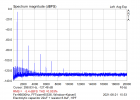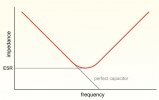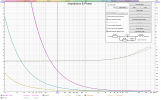Not the most helpful though: multitone graphs are quite hard to (visually) read, one needs a calculator to figure out what all those distortion byproducts are. Also it is ~impossible to visually compare two multitone graphs (unless the diffs are huge).
This part of the series on " capacitor sound" is primarily about ABX Test and the music and noise samples.
How small the difference in MD is with capacitors in crossovers has already been shown in detail in the other parts. For electrolytic capacitors versus film capacitors with an low distortion midrange driver (
part 2) and for another high-end film capacitor versus normal and old film capacitors (
part 1):


If you can hardly recognize a difference visually and the small differences that are really recognizable are greater than -60dB below the fundamental, this can never explain the listening impressions in the reviews of high-end capacitors. No one should be able to tell whether the MD is at -60dB or -63dB.
Erin from erinsaudiocorner regularly makes MD measurements. His personal hearing limit is around 3%. Even if an audiophile believes that one can perceive a magnitude better MD, one would only be at 0.3%, to -60dB (which means 0.1%) is still a long way off.
Don't get me wrong, for example, there are clearly measurable differences between electrolytic and film capacitors when it comes to harmonic distortion. This has been shown by
@pma in
this post in part2:

But you have to be aware that these measurements were carried out at a voltage of around 10V (a standard mid-range driver shows well over 100dB SPL at this voltage) and HD3 was around -70dB (0.03%) for the electrolytic capacitor, whose dielectric strength was only 63V instead of the usual 100V. This is all far below the threshold of perceptibility - masking prevents its audibility.
How about a fullspectrum HD graph?
The ones provided by Archimago look pretty nice & easy to read.
As you probably know, multitone measurements contain both harmonic distortion and intermodulation distortion. So if multitone distortion is practically identical, then there is no difference in HD.
By the way, I have already answered the question regarding
HD in post#628, for example - no need to explicit show HD measurements of film capacitors, it was settled decades ago.
Let me quote myself:
Distortion of film capacitors plays no role at all in crossover, as it is extremely low and magnitudes lower than the distortion caused by drivers.
For example, take a look at the
measurements of film capacitors by Cyril Bateman from 2002/3 - that's how long ago the matter was settled. By the way,
@pma has already confirmed these measurements several times and has measured,
for example here, harmonic distortion of capacitors at
20Vrms (!!) - 100% inaudible.

But proving inaudibility in a sure/fool-proof manner is not an easy task, it might just be the hardest ever (generally, proving negatives is quite close to impossible).
If you still can't accept the facts after all the evaluations and the zero test with DeltaWave, you can easily check for hours with the music samples and an ABX test to see if there are any audible differences.
If someone is not able to hear differences in the ABX test, then you have proven that you yourself are not able to detect differences.
It's never too late to abandon old superstitions instead of repeating them again and again without proof

something that should be added to your first-post: a nice intro-to-caps article.
I would recommend "
Thinking Caps" and its
biblio: an easy & clear read and it also contains a few thoughts on how they
may sound different
There are plenty of online electronics encyclopedias that explain how a capacitor works in a compact way.
From your link, claims like
"Large electrolytic capacitors typically have electrical resonance frequencies within the audio band" are really problematic. What does "large" mean and where are the measurements that show this behavior and explain why any high or low pass behavior is considered a resonance.
Theoretical behavior of a capacitor shown in your link with the "problematic, misleading statement" I quoted:

What does reality show?
Impedance measurement of a typical 3.3µF standard film capacitor which could be used in a crossover part to a tweeter:

The influence of the Equivalent Series Inductivity ESL is not even dominant above 40kHz.
Impedance measurement of a 110µF electrolyte capacitor. Such high capacitance is actually only used in series with the driver in the midrange branch (high pass to separate from woofer).

Now we can just about recognize an impedance minimum around 20kHz and observe the increasing influence of ESL above 20kHz.
In addition, the quality factor Q is very small, so it is a critically damped or over-damped system and the system doesn't oscillate.








